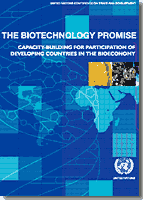
Biotechnology has been a subject of great public interest since the late 1980s. By 1992, through Agenda 21 of the United Nations Conference on Environment andDevelopment (UNCED), the international community recognized the important rolethat biotechnology would play in agriculture, health, industry and environment. Anumber of national leaders saw biotechnology as a vehicle through which developing countries could leapfrog to achieve national development.
The international community also recognized the need to help developing countries build sufficient human resources, regulatory capacity, research funding and governance institutions to enable their participation in biotechnology. Significant strides have been made in biotechnology development beyond those anticipated in 1992, but developing countries have increasingly remained behind.
Many programmes and initiatives have been developed by different international and regional institutions to help developing countries build national capacity in biotechnology. While the focus of international organizations and industry was on biotechnology opportunities, the public has become increasingly suspicious of some biotechnology products. The greatest resistance was to agricultural biotechnology products, where human, animal and environmental health risks dominated the debate. This debate has diverted the attention of national and international organizations from the wider benefits of biotechnology.
The United Nations Commission on Science and Technology for Development(CSTD) acted in a timely fashion to help developing countries come to terms withbiotechnology issues. This report departs from mainstream work done so far inbiotechnology as it focuses on successes and steps taken by developing countries and countries with economies in transition to build national biotechnology industries. This report does not focus on biotechnology research but rather on biotechnology industry development.
The report does identify some of the common features of successful biotechnology development models in case analysis. It also points out the important roles, in some case complementary roles, of each biotechnology sector, such as industrial and environmental biotechnology, or the role of plant biotechnology in the growth of industrial and pharmaceutical sectors. The level of financial resources that kickstarted the various projects are highlighted where information is available.
The report is different from previous ones on biotechnology in three major aspects. First, it focuses on opportunities and challenges rather than just benefits and risks that have dominated public debates. It argues that unless the opportunities are taken and challenges addressed, benefits and risks will remain obscured by economic and social considerations rather than just science.
Secondly, the report addresses the wider application of biotechnology and supports this line of thought with country case studies to develop models that may be used by developing countries at different stages of development. It presents different models and suggestions based on successful cases from developing countries.
Thirdly, the report takes the reader through most of the stages of developing a biotechnology industry. It presents both private and public initiatives with pointers on how and why some cases were successful. It admits that a one-size-fits-all model in biotechnology may not work. This makes the report unique.



